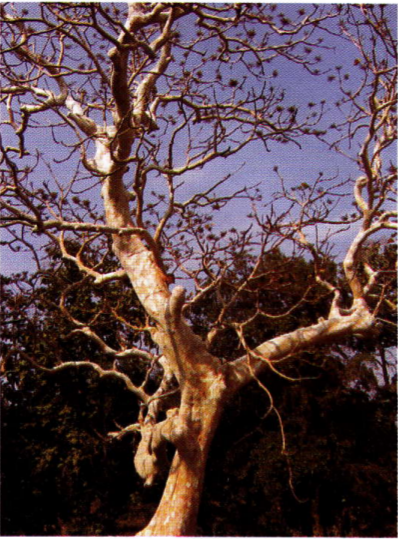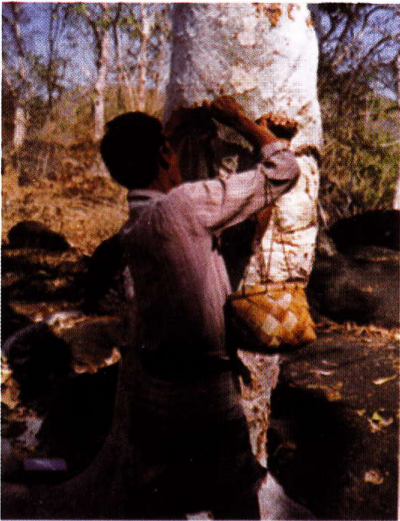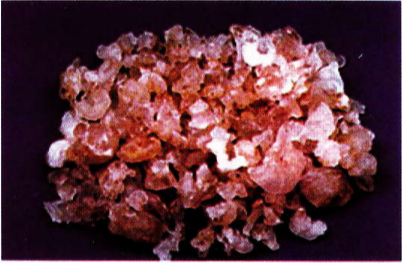Gum Karaya
Gum Karaya
Gum karaya, also known as Indian tragacanth is the dried exudate obtained from trees of Sterculia species (mostly from Sterculia urens).
Local names : Hindi: Gulu, Kadaya, Karaya,Katera, Katilo, Kullo; Telugu:Tapsi
Plant Source : Sterculia urens Roxb.
Family : Sterculiaceae
Distribution : Sterculia urens are usually found in tropical dry rocky hills and plateau. It is always noticeable from its smooth greenish-gray bark or white stem peeling off in large papery exfoliation, especially in the hot season, and the gaunt white stem with stiff spreading branches. The tree starts shedding its leaf in the cold season and the panicles of flowers appear from December to March at the end of leafless branches. Young leaves sprout in the hot season,
Sterculia urens is indigenous to India having a wide distribution It is abundantly found in the dry deciduous forests in Madhya Pradesh and Chhattisgarh, which in earlier contributed about 50% of gum production in the country and the remaining came from Andhra Pradesh, Rajasthan, Gujarat, Odisha, Maharashtra, Karnataka and Tamilnadu.However,a greater proportion of recent production comes from Andhra Pradesh.
Production in India : 1500 tons per annum (approx.)
Other producing countries : Sudan and Senegal (where gum karaya is obtained from Serculia setigera)
Harvesting /Collection of Gum
Method of harvesting/tapping: The locals tap the trees by making incisions upto one square foot in dimension on the trunk. The gum begins to exude immediately and the exudation continues for several days. The maximum amount of exudation occurs within the first 24 hours. The gum is in the form of large irregular tears.The tears are picked by the locals who sell the same to the forest contractors registered with the TRIFED. In the state of Andhra Pradesh,the purchases of raw gum karaya are centralized through the state owned Girijan Co-operative Society.
upto one square foot in dimension on the trunk. The gum begins to exude immediately and the exudation continues for several days. The maximum amount of exudation occurs within the first 24 hours. The gum is in the form of large irregular tears.The tears are picked by the locals who sell the same to the forest contractors registered with the TRIFED. In the state of Andhra Pradesh,the purchases of raw gum karaya are centralized through the state owned Girijan Co-operative Society.
Period of harvesting/collection : The best quality gum is collected during April, May and June i.e. in summer. During this time, as the weather gets warmer the yield increases.The gum collected during the monsoons has low viscosity.In September, after the monsoon, the collection cycle is repeated.
During this time, as the weather gets warmer the yield increases.The gum collected during the monsoons has low viscosity.In September, after the monsoon, the collection cycle is repeated.
Yield : A tree of about 1.5 to 2 m girth with two blazes yields 2 to 5 kg of gum in a year and may produce up to 10 kg depending upon the locality, size and vigour of the tee and method of tapping.
Processing and Value Addition
Gum collected by the villagers is delivered to the agents appointed by the trading corporation at rates fixed according to quality of gum. It is then packed in gunny bags and transported to towns. The gum often contains many impurities like tree bark etc.
At the grading centre the big lumps are broken into small pieces of about 1 to 3 cm in diameter. The broken pieces are then graded manually in five different grades, which are registered with the Indian Agmark Organisation, and which are based mainly on criteria of viscosity, colour and free from external bark, sand etc.
Gum is further purified by size reduction and removal of pieces of bark by air flotation methods. Other mechanical methods are used to remove sand, dirt and other types of foreign matter. Gum karaya is also granulated and powdered for obtaining a homogenous dispersion. Granulated or crystal gum karaya are usually processed so that the particle size is between 6 and 30 mesh.These granulated gum karayas are used principally as bulk laxatives.
Other mechanical methods are used to remove sand, dirt and other types of foreign matter. Gum karaya is also granulated and powdered for obtaining a homogenous dispersion. Granulated or crystal gum karaya are usually processed so that the particle size is between 6 and 30 mesh.These granulated gum karayas are used principally as bulk laxatives.
Storage : Gum karaya tends to agglomerate or form lumps when exposed to wet and humid conditions.Therefore ,handling recommendations include storage in sealed polythene lined containers. For extended storage, materials should be warehoused in a cool,dry places
The graded gum is packed in heavy duty bags of about 80 kg each. Sometimes the gum is powdered and packed in 5 to 6 kg kraft paper bags or 75 to 100 kg fibre drums. In dry form, gum karaya loses viscosity in storage,especially under high heat and humidity. The rate of loss for powdered material is more as compared to granules. To minimise this,storage under colder temperature is advised. The viscosity loss of Karaya dispersions in storage can be minimised by the addition preservatives like benzoates, sorbates, phenols, and related compounds
Quality control : There are at least five lndian grades of karaya: HPS (Hand Picked Selected) Superior No.1 and No.2 (Fair Average Quality) and Siftings.The first four grades are the main export grades.The main quality criteria at the sorting stage are colour and foreign matter although even after grading the quality of consignments is often variable .The higher grades should be cleaner and paler than the lower ones,which may be dark brown in colour and have bits of bark present A BIS specification (lS 12408:1988) exists for food grade gum karaya.
Properties
- Gum karaya is an acidic, partially acetylated polysaccharide
- lt is white or intense ruby in colour and solidifies into large,roundish tears
- It is not soluble in water but swells into a jelly like mass in water. lt absorbs water at very rapidly to form viscous mucilages it is one of low concentrations, although the least soluble among exudate gums.
- Karaya is a calcium and magnesium salt,with a central chain of D-galactose, L-rhamnose and D-galacturonic acid units, with some side chains containing D-glucuronic acid.
- Heating gum karaya dispersions increases the,solubility but results in permanently lower viscosities.
- Gum karaya is approved for food use and is in the GRAS (Generally Recognized Act Safe) list under the Food and Drug Act properties to yield finished products.
Industrial Applications
- Used in dental adhesive products
- Used as a bulk laxative
- As an adhesive for ostomy rings
- It is used as a stabilizer for dairy and frozen desserts.
- It is used as an acid resistant stabilizer for sherbets, fruit ices and similar low pH products.
- It is used in stabilizing packaged whipped cream products, meringue toppings and aerated dairy foods.It is also used to improve the spreadability characteristics of cheese spreads.
- lt is a good emulsion stabilizer for French style salad dressings.
- It is used as a binder for making low calorie dough-based products such as pasta, bread and other bakery products .
- It is used in ground meat products as it provides good water holding and binding.
- In the paper industry, it is used in the manufacture of long fibered, light weight Paper
- It is used in textile printing operations as a thickening agent for the dye in direct color printing on cotton fabrics.
Last Modified : 3/1/2020
This topic provides information about Guggul or In...
This topic provides information about Asafoetida.
This topic provides information about Guar gum.
Dammar designates a group of resins obtained from ...
